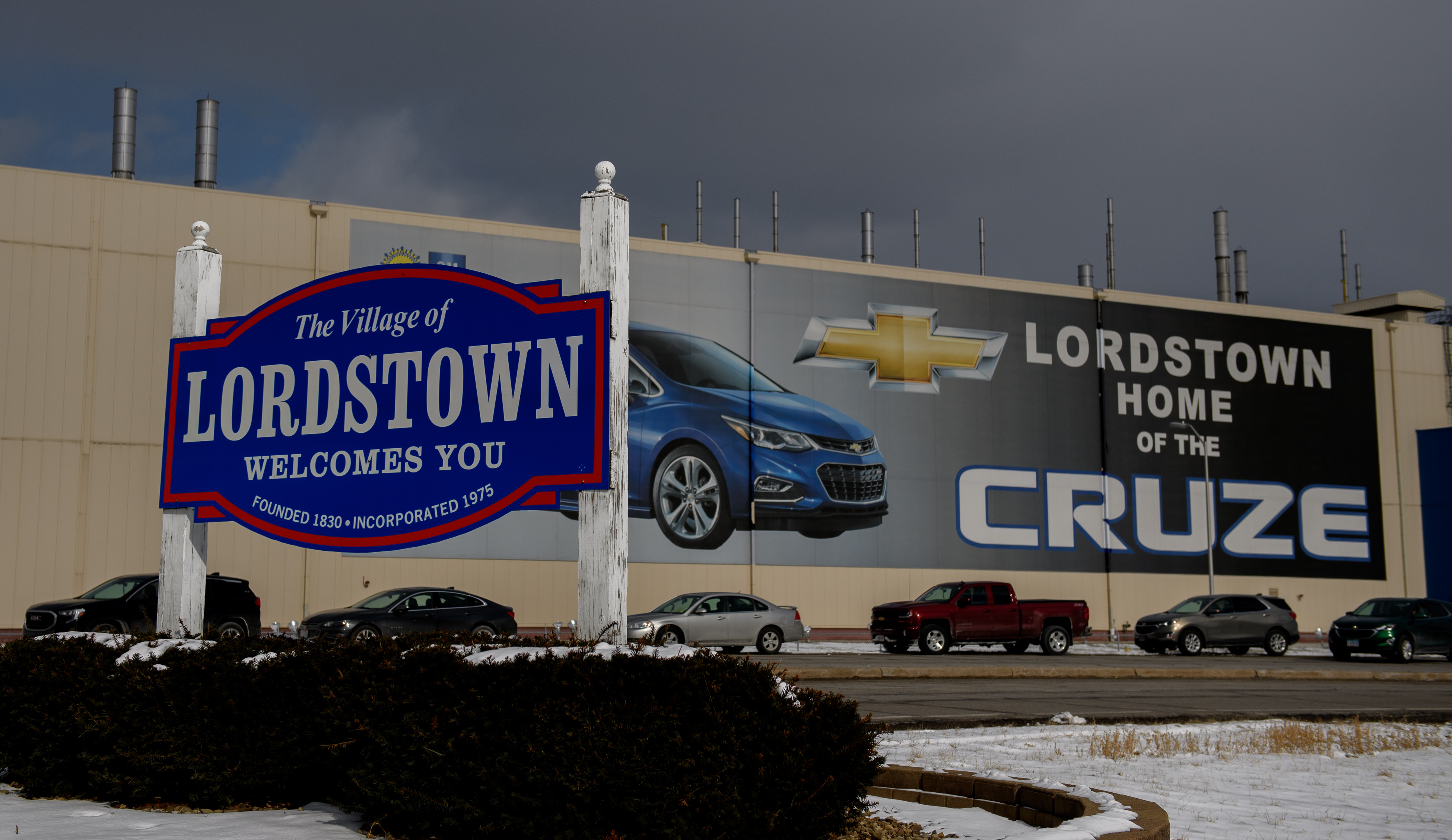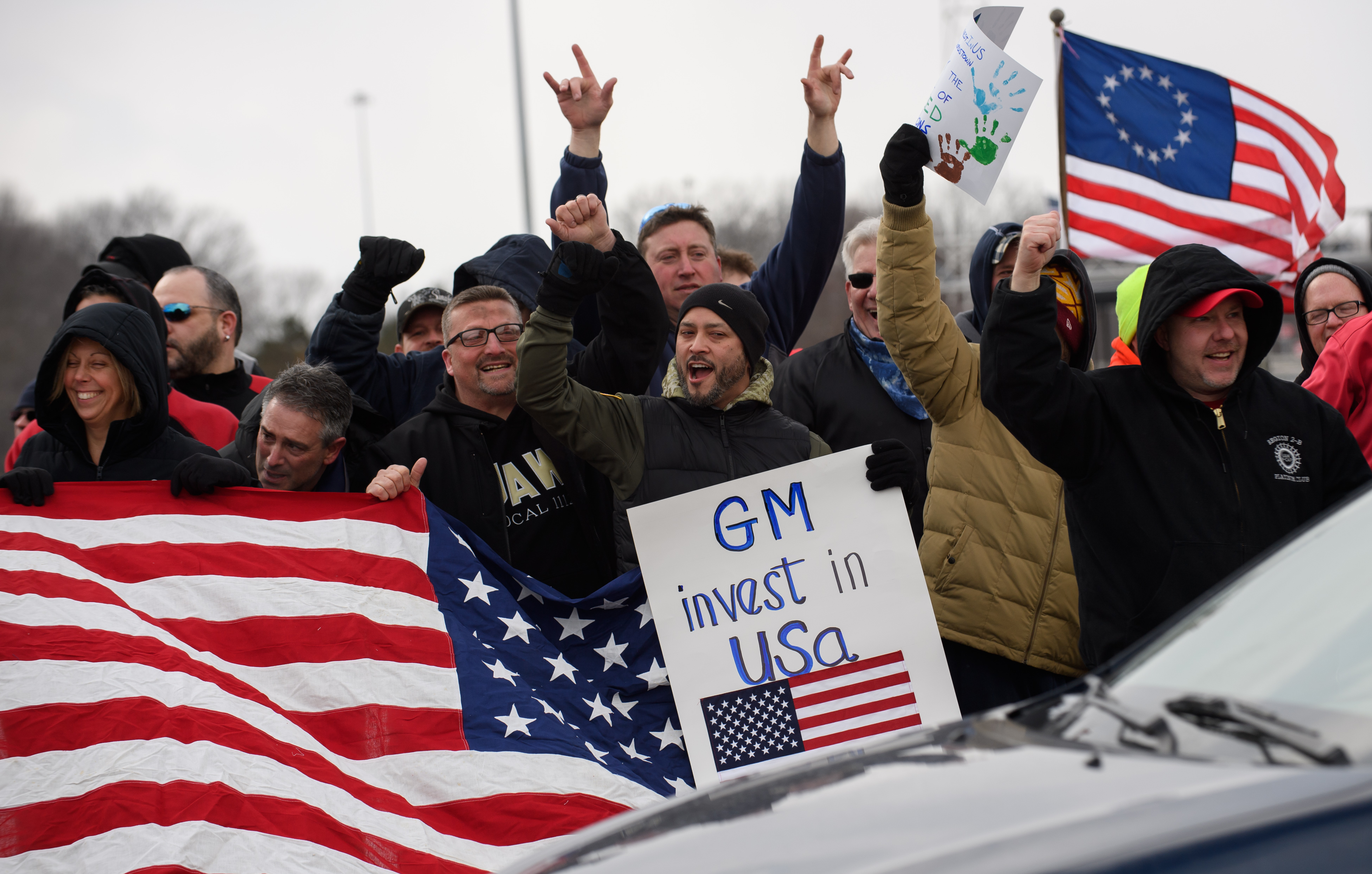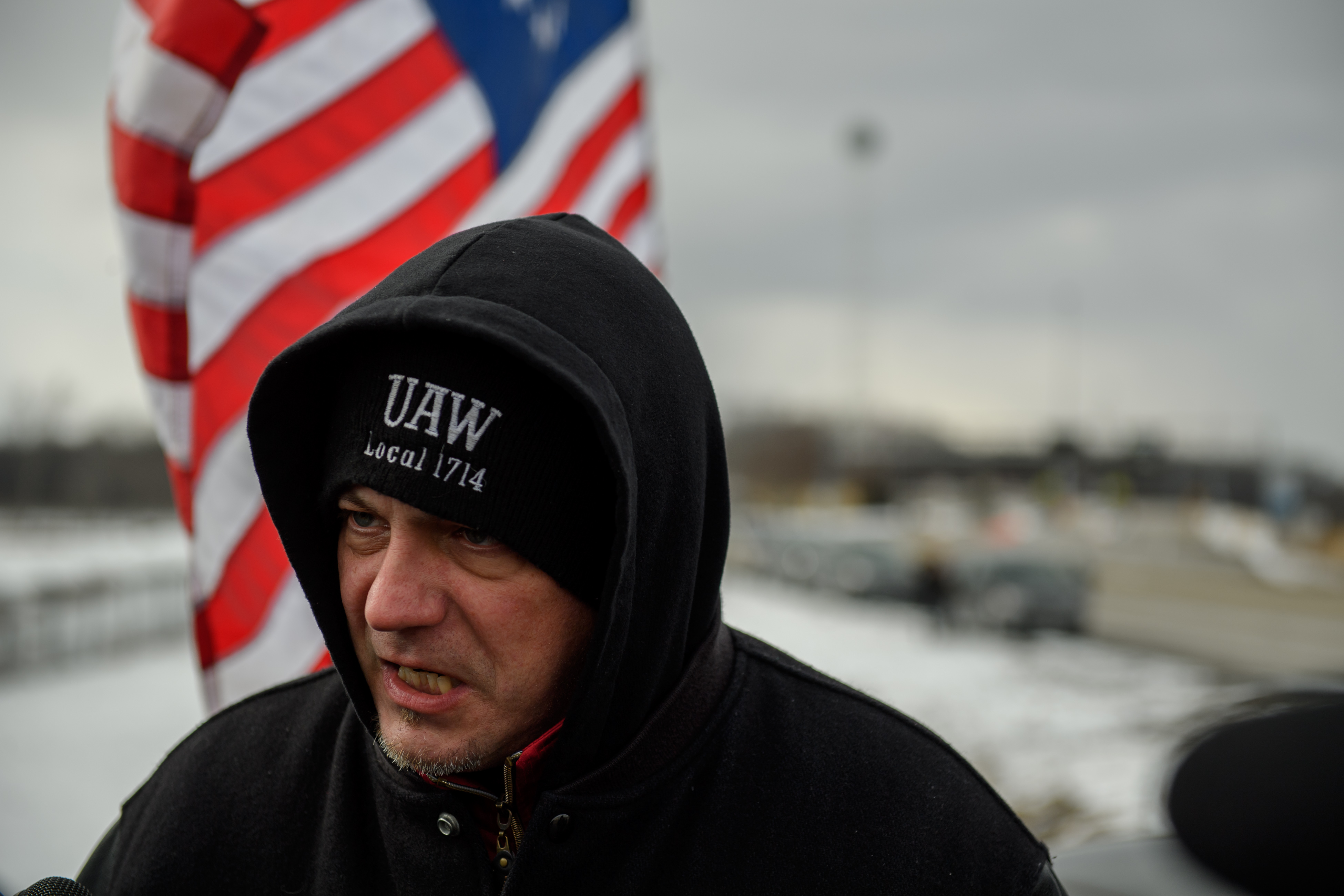If David Green is sure of anything, it’s that this has happened before.
From the decades before General Motors “unallocated” its Chevy Cruze plant in Lordstown, Ohio, there are a litany of examples of plant closures. The president of United Auto Workers Local 1112 recalls assembly liners divorcing their wives in the 2000s after a forced relocation sent them here from Flint, Michigan. He remembers seat makers—”hog ringers,” in autoese—being laid off from Magna Seating Systems due to outsourcing in the years after. He can bring to mind names of sanitation workers, HVAC men, bathroom cleaners, bulb changers, and floor sweepers that used to be GM employees, most of them for decades: a new Black Monday came, and then they weren’t.
But he still wasn’t prepared for Lordstown. Sure, he had seen telltale signs long before the storm: Since his appointment as union president last March, GM had downsized Lordstown’s facility from three shifts to just one that June; Local 1714, a nearby union hall Green had once led, was absorbed on GM’s urging into 1112 (to save $3 million a year). A week before GM announced the “unallocation”—a corporate euphemism meaning shutdown—of the Lordstown plant, Green had just initiated Drive It Home, a cross-sector campaign promoting local business, as if to bolster the village’s collective worth in spite of GM gradually inching out—to “provide hope” in the midst of uncertainty.
“You know, I understand economics a little bit,” Green, a fast talker with an unrestrained sense of humor, says. “I mean, we’ve seen this shit happen here in the Valley for years. Job loss, job loss, job loss. Youngstown, Warren. Steel mills have closed. But I’d be lying to say I expected this now.”
On November 26th, around nine o’clock in the morning in the hall located a 10-minute drive from the plant, 1,500 UAW-GM workers were given a staggering notice: The 53-year-old factory that single handedly built and assembled the Chevy Cruze would be empty by the following March. After all, auto manufacturers claimed, the future was SUVs and trucks (GM sold 142,000 Cruzes in 2018, a huge drop from 248,000 in 2013). At 9:30 a.m, Green walked out to the gym-sized work area and delivered a downcast speech for the media. After a reporter asked him how he felt, Green admitted, “I honestly feel like I’ve been kicked in the stomach.”
Almost immediately after Green delivered the news, International UAW sprung into defense. The most recent “UAW-GM National Agreement” states that GM can’t “idle” or “close” or “shutdown” a plant until September of 2019, when the agreement will be renegotiated. Knowing this, UAW staff drove to Youngstown to file a lawsuit claiming a breach of labor contract, citing that, by GM “unallocating” the Lordstown plant, it was using semantics—a different term with the same functional meaning—to weasel its way out of producing the Cruze. Mary Barra, GM’s chief executive officer, argued shortly thereafter the shutdown was legal, intended to “do the right thing for our employees, but also make sure General Motors is strong and lean in the future.”
UAW didn’t buy it one bit. “There’s no material difference between unallocating a plant and idling or closing a plant for purposes of the Company’s obligation,” the submitted suit, which GM is trying to throw out, reads.
Green prefers to slice through all the legalese, and get straight to the point. “It’s a chess piece,” he says. “GM is making record profits, the strongest they’ve been in my lifetime. They don’t want to make cars anymore. I mean, Apple doesn’t manufacture their phones, do they? Why doesn’t every company do it that way?”
Green answers his own question. “Because us unions are stopping them.”

An auto plant closure in a small, rural town always sets off a chain reaction. Thousands of laborers are laid off, and then can’t pay their mortgage, so “For Sale” signs sprout up. If workers sign involuntary transfers—”take the gig in Fort Wayne, or not get retirement,” as Green says—then their spouses will hand in notices too. The same goes for their kids enrolled in the local school, and then the teachers that guide them. Then the layoffs undulate further: restaurant owners, church pastors, part-time tutors, dance instructors, dry cleaners, team coaches, parts suppliers, Dairy Queen cashiers, day care staff. According to the 10-1 multiplier effect (observed by Lansing, Michigan, Mayor David Hollister in his book Second Shift, after a similar layoff there in the 1990s), if Lordstown is losing 1,500 UAW-GM workers this year, roughly 10 times that will be affected state-wide by the time 2021 rolls around.
“One of the things my kids were telling us was: ‘Oh the school’s gonna close! The school’s gonna merge!'” says Terry Armstrong, superintendent of Lordstown Local School District. “Right now, they’re all afraid, saying, ‘I’m going to have to say goodbye to my friends.'”

(Photo: Jeff Swensen/Getty Images)
Like many of the politically concerned in Lordstown, Armstrong stays in regular contact—usually once a week—with Green. Armstrong is preparing to witness up to 75 students say goodbye come the next school year, along with 21 full-time and part-time staff, including the Red Devils’ baseball coach and a cohort of tutors. To handle the stress, Armstrong contracted a nearby mental-health agency in Niles, Ohio, called Homes for Kids, which sends licensed therapists to speak one-on-one with students whose parents have been laid-off. “We’ve had to tap into that much more than we used to,” he says. “I mean, a lot don’t even know why their friends are leaving in the first place.” (Homes for Kids said they’ve helped “over a hundred” students since GM’s announcement in November.)
In Austintown, Ohio, a suburb 20 minutes south of Lordstown, the ripple has been felt equally, maybe even worse. Austintown School’s superintendent Vince Colaluca told me that the system is prepared to let go off 10 percent of its workforce by 2020, eliminating up to 40 teachers. “I’ve been working here 13 years,” Colaluca says, “and we’ve never made cuts this big.”
Across the street from Lordstown High School, past the freshly paved track that the Lordstown Energy Center funded, is the Our Place Diner, where Niki Reid has worked most of her adult life. On the menu are “Trucker Smash” and “GM Chicken Fenders.” Since the closure announcement, Reid says the Diner’s been all abuzz with GM talk, gossip about Barra (“I think she’ll get what’s comin’ to her”), and tough speculation on what’s to come in July, when UAW and GM will undergo their first round of talks concerning Lordstown. Though Reid can’t say how her job will be affected, she’s more concerned about the faraway future.
“As a member of the [Board of Education], it’s our job to be responsible,” she says, in the midst of taking orders. “But as a momma myself, my biggest concern is for these kids. I mean, what if there’s no school? That’s what keeps me up at night.”
Driving around Lordstown, a village of 3,700, you can see tiny cries for help and sympathy, dotted around corner gas stations, Americana cafes, and the Dollar General. For every sign reading “DRIVE IT HOME,” there’s one that reads “SAVE THE GM PLANT.” Whether on Salt Springs Road or Tod Avenue, you can count dozens of Cruzes or GMC Terrains that zip by, reminders of whose town this really is. If you head south on Tod, you can see the future sites of a TJX distribution center and the Energy Center, sprouting up around existing distributors advertising job openings. Plausible hope, in other words.
Inside one business, a minute north of the plant on Ellsworth Bailey, sits Doris Hays, of Hays Enterprises, Inc., a shopping cart distributor. When asked if her “NOW TAKING APPLICATIONS” sign in front is related to the closure, Hays responds with a kind of skeptical openness.
“I wouldn’t say assembly line work automatically makes one qualified for what we do,” she says. “But hey, I guess we’ll take a look at any resumé.”

David Hollister is a UAW-GM legend by several measures. His story seems boilerplate at first: One day in 1996, when Hollister was mayor of Lansing, Michigan, he received a knock on his door from GM representative Edward Donovan, a mediator Hollister had had a “close relation” with since the late 1980s. In an hour conversation, Donovan told Hollister that the Oldsmobile line was being shut down at the end of the decade: “There’s no use for it; it’s an outdated car.” The mayor was appalled. “In most cases, once the decision is made to close a plant,” he wrote in his book Second Shift, “it is irreversible.” (Hollister could not be reached for comment.)
Hollister faced down an imposing history: In the 1980s, when Japan and German auto manufacturers disrupted the American auto market, companies like GM were acting no holds bar to repair profit margins. (GM was accused of “whipsawing,” that is, encouraging neighboring plant rivalries to save their jobs.) It happened in Van Nuys, California, one of the last hold out plants before GM pulled out of the West Coast. It happened big across Michigan, in 1986, when seven plants were shuttered, a devastating blow that cost 27,000 people their jobs.
For GM, it was all framed as necessity. One industry analyst at the time dubbed the seven-plant closure “a positive step for the company.”
“It never was about community. Not about location,” Greg Miller, a historian at Kettering University (formerly the GM Institute) in Flint, Michigan, says about the closures. “It was all always about one thing: profits.”
Miller, who wrote his graduate dissertation on Lordstown, says that the history of the UAW and GM is a history of power dynamics. In 1972, citing overworked conditions, assembly line workers at Lordstown protested by sneaking Coke cans filled with loose bolts inside car doors (the cars were eventually sent back). In the 1980s, Flint and Lansing workers pushed through 12-hour shifts to try and keep their plants alive despite the possibility of being “idled.” Flint’s ended up going first, despite a UAW fight.
In the New York Times report on Flint’s closure, a George Washington University labor specialist named Sar. A. Levitan analyzed the shutdown: “Often you find that clauses written into contracts protecting job security seem to go by the wayside when it comes to company survival or corporate profits,” he said. “And that seems to be the case here.”

(Photo: Jeff Swensen/Getty Images)
In Lansing, however, Hollister didn’t accept history. He formed a special committee with the aim of convincing GM to re-tool the Lansing plant to produce the Chevy Alero. After all, Hollister’s family was a GM family (his father and father-in-law both did assembly work). The committee would convince higher-ups that they could build the Alero on a second shift, and Lansing’s plant was saved: one of the only times in GM history that happened.
Whether a similar solution could spare Lordstown, Miller isn’t sure. He gives two separate scenarios. “Before GM was built, Lordstown was just a couple of gas stations on the way to Youngstown,” he says. “Then, they got the infrastructure. A school system. Improvements as a village.” Miller takes a breath. “And now? You’ll probably see the decline of all of that. Unless, of course, something happens.”

On the afternoon of March 17th, Green left an interview with Fox News to find his name being mentioned all over Twitter, all because of the president of the United States. “Democrat UAW Local 1112 President David Green ought to get his act together and produce,” Donald Trump wrote. “G.M. let our Country down, but other much better car companies are coming into the U.S. in droves.”
It had been a little over a week since the plant had emptied on March 9th, and, as a result, the UAW offices filled. Green’s phone was ringing repeatedly; reporters were eager to get commentary. “It seemed like such a knee-jerk reaction to me,” Green says. “There’s a fire going on here, and Trump threw a bucket of gasoline on it.”
Before the tweet, Green had mailed Trump three letters, in July of 2018, January, and February, and was shocked that this was the ultimate reply: blaming him for Lordstown’s closure. The union head wasn’t swayed in the slightest. “I have to respect somebody for their insults to matter,” he says. (As Local 1112 president, Green is not in charge of contract bargaining; Shop Chairman Dan Morgan is.)
Since March, Green’s life has been in constant turmoil. He receives a barrage of emails every day from those condemning him for Lordstown’s decline, and from others who offer ideas for its repurposing (building Tesla cars, scooters, bicycles, hydrogen-electric vehicles, airplanes, trains, or buses). He adopts a variety of roles: a job fixer for some, mental-health guide to others, Angry Union Boss for the rest of the country. He harbors calls from members of Congress and presidential hopefuls, albeit with a grain of salt: Green is a lifelong Independent, cautious of politics. “My dad used to say, ‘Management will eat you up, and spit you out,'” he says, “and, well, look what happened.”

(Photo: Jeff Swensen/Getty Images)
On a recent Wednesday at Local 1112, Green reviewed forced transfer policies, occasionally shouting hello to GM transferees who passed by his door. Getting workplace coffee, he hugged UAW coworkers he has known for decades and shook hands with newcomers.
But who is to guide Green? After all, if the Lordstown plant isn’t revived or repurposed, he’ll need to find work too. “I need to keep my health care,” he says. “I have two daughters in college. For every year I don’t work, I have one more year until my retirement.”
Around two o’clock that day, a man sporting a jean shirt and loose pants walked into Green’s office, holding a transfer form at his waist. In contrast with Green’s optimistic bent and quirk, he looked pretty sullen. “How ya doing?” Green asked. “Are you getting bored, yet?”
“No,” the man said. “I’m just thinking about what I’m gonna do.”
“Are you looking to transfer out?” Green asked.
“I’m looking at additional schooling. Right now, I’m gonna go fill out a resumé. I’ve been out three weeks, but I wanna see if I’m eligible for TRA [trade adjustment assistance].”
“Dude, that’s what I’m doing. What’s your date?”
“August of ’96.”
“I’m a ’95-er,” Green said, “and I’m getting laid off at the end of May. That’s my fear, right? That I’m gonna get forced to Texas.”
The man sighed, then mentioned his wife, who was also debating a job in Fort Wayne. “I mean, she could go out on Social Security disability, but she’s fighting it with every last fiber of her body,” he said. “I’m letting her know that she’s got whatever she wants from me. It’s not like I’m gonna leave her—I’ve been with her 38 years. That’s what’s agitating. Neither of us missed work, neither one of us played games—nobody did.”
Green smiled in spite. “Five percent of the people create about 90 percent of your work,” he said.
The man laughed. “And you know what?” he said. “I’ll take their names to my grave, because I still haven’t forgotten them, yet.”




